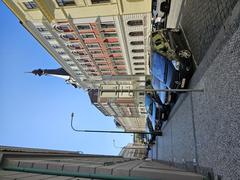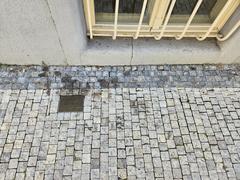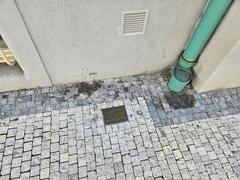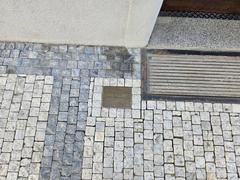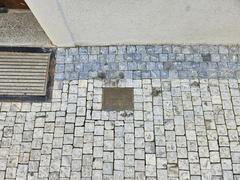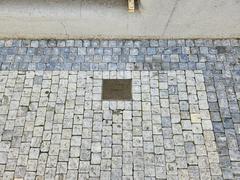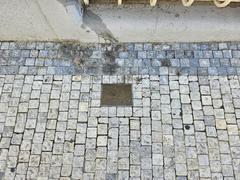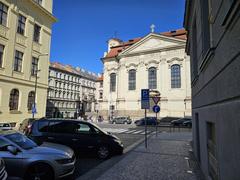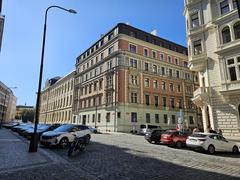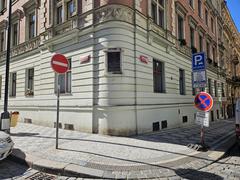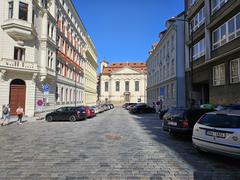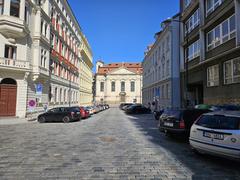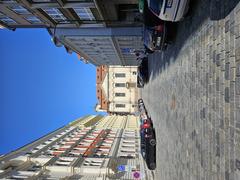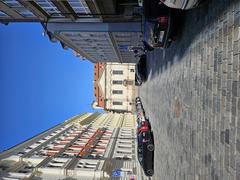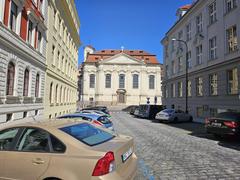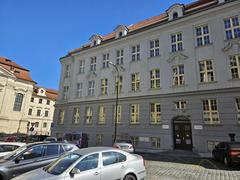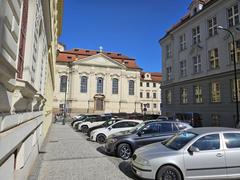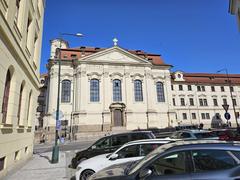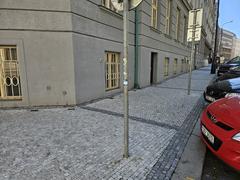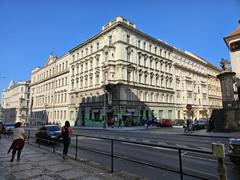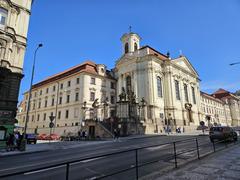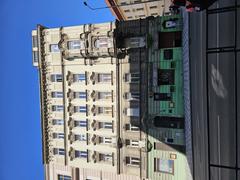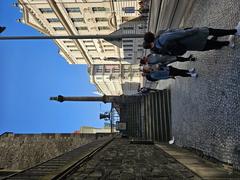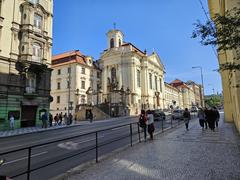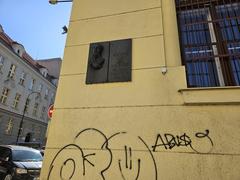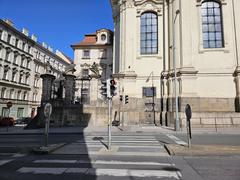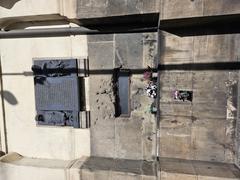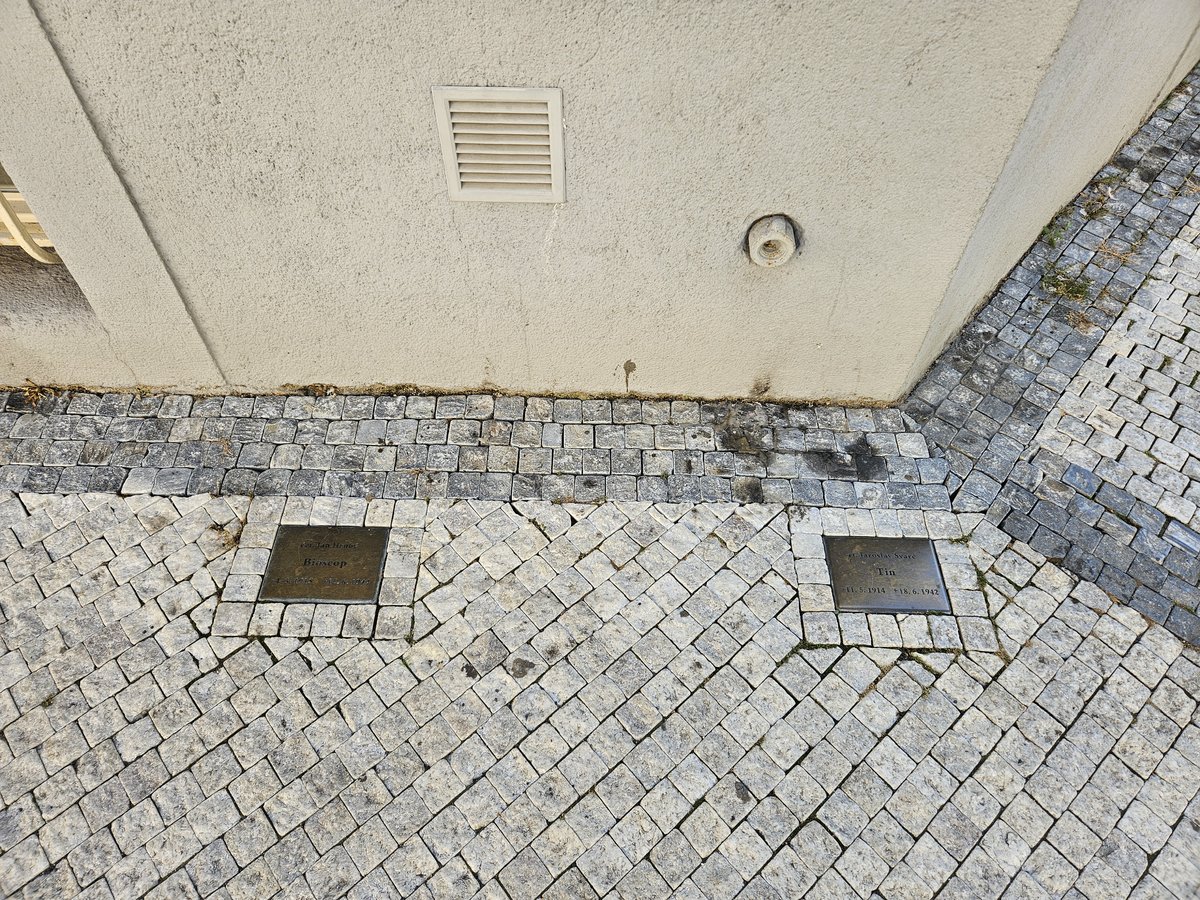
Ss Cyril and Methodius Cathedral Prague: Visiting Hours, Tickets, and Travel Guide
Date: 14/06/2025
Introduction
Nestled in central Prague, the Ss. Cyril and Methodius Cathedral is a profound symbol of Czech spiritual heritage, national resilience, and architectural splendor. Dedicated to Saints Cyril and Methodius—Byzantine brothers known as the “Apostles to the Slavs”—the cathedral invites visitors on a journey through centuries of religious, historical, and cultural evolution (pragitecture.eu; nomads-travel-guide.com).
Set on a site with sacred roots stretching back to the 9th century, the cathedral has witnessed transformative periods: from medieval monasticism, through Baroque grandeur, to its 20th-century role as the principal Orthodox church in Prague (OrthodoxWiki). Its architecture harmonizes neo-Byzantine and Baroque elements, featuring ornate domes, vibrant mosaics, and a richly adorned interior, all reflecting the Orthodox faith and Czech identity (Evendo).
The cathedral is also a poignant site of modern history, serving as the final refuge for Czech and Slovak paratroopers involved in Operation Anthropoid, the 1942 assassination of Nazi official Reinhard Heydrich. The crypt, now the National Memorial to the Heroes of the Heydrich Terror, commemorates their sacrifice and the enduring spirit of Czech resistance (Prague Experience; bbc.com).
This guide provides essential details on visiting hours, ticketing, guided tours, accessibility, architectural highlights, and historical context—ensuring an informed and meaningful visit to one of Prague’s most significant landmarks (Prague.eu; Prague Ticket Office).
Historical Background
Early Origins
The origins of Ss. Cyril and Methodius Cathedral trace back to a church established by Duke Bořivoj I, Bohemia’s first Christian ruler, in the 9th century. Tradition recounts that St. Methodius himself consecrated the original church on this site. Over the centuries, the area grew in religious significance, hosting a church dedicated to Ss. Peter and Paul by 1115 and the Zderazský Monastery, a vital medieval religious center. The Hussite Wars of the 15th century led to the destruction of most of the original structures, leaving only fragments of the choir intact (OrthodoxWiki).
Baroque Construction
The current Baroque church emerged between 1730 and 1740, initiated by Archbishop Brener and designed by architects Pavel Ignác Bayer, Kilian Ignác Dientzenhofer, and Kristian Spannbruker. Initially dedicated to St. Charles Borromeo, the church’s ornate façade, dynamic forms, and elaborate interiors epitomize Czech Baroque ecclesiastical architecture (OrthodoxWiki).
Secularization and 19th-Century Use
During the reforms of Emperor Joseph II, the church and adjacent retirement home were secularized in 1783 and repurposed as military storehouses and barracks. Later, in the 19th century, the building also served as a technology center, reflecting the shifting tides of Czech history (OrthodoxWiki).
Orthodox Revival
The 20th century marked the church’s transformation into a principal Orthodox cathedral. In 1933, the Czechoslovak government granted the Orthodox Church use of the former St. Charles Borromeo church. The first Orthodox consecration took place in 1935, with relics of saints interred beneath the altar, and the church was rededicated to Ss. Cyril and Methodius (OrthodoxWiki).
World War II and Operation Anthropoid
In 1942, during Nazi occupation, the cathedral’s crypt became the final refuge for the resistance fighters who assassinated Reinhard Heydrich. After a fierce battle with Nazi forces, the paratroopers perished in the crypt, transforming the site into a memorial to Czech resistance (Prague Experience; View from Prague).
Architectural and Artistic Highlights
Neo-Byzantine and Baroque Synthesis
The cathedral’s design harmonizes neo-Byzantine and Baroque features. Its façade boasts grand archways, vibrant mosaics depicting its patron saints, and twin onion-domed towers topped with gilded crosses. The main dome and rounded arches evoke Byzantine tradition, while the dynamic forms and ornamentation echo the Baroque period (Evendo).
Interior Experience
The nave is spacious and awe-inspiring, following the Orthodox cross-in-square plan. The sanctuary is separated by an elaborate iconostasis adorned with icons of Christ, the Virgin Mary, and saints. Frescoes and mosaics by Czech and Russian artists, including a monumental Christ Pantocrator in the central dome, create a solemn atmosphere.
The Crypt: National Memorial
The crypt, preserved as the National Memorial to the Heroes of the Heydrich Terror, features original bullet and shrapnel marks, commemorative plaques, and an evocative exhibition on Operation Anthropoid. It is a place of both historical reflection and reverence (Evendo).
Religious Artifacts
The cathedral houses hand-painted icons, silver chalices, embroidered vestments, and relics connected to its Orthodox tradition and Czech history.
Religious and Cultural Significance
Saints Cyril and Methodius
The cathedral’s dedication honors Saints Cyril and Methodius, the 9th-century Byzantine missionaries who created the Glagolitic script and fostered the spread of Christianity among Slavic peoples. Their legacy shaped the spiritual and cultural identity of Central and Eastern Europe (pragitecture.eu; nomads-travel-guide.com).
Center of Orthodox Worship
Since 1935, the cathedral has been the principal Orthodox church in Prague, hosting regular liturgies, feast days, and rites of passage. It stands as a symbol of faith and resilience, particularly during periods of political oppression (wikipedia.org; nomads-travel-guide.com).
Memorial of Resistance
The crypt memorializes the heroic stand of Operation Anthropoid resistance fighters, making the cathedral a site of national remembrance and pilgrimage (bbc.com).
Interfaith and Pan-Slavic Importance
The saints are venerated by Orthodox and Catholic communities alike. The cathedral’s interfaith and pan-national symbolism is reinforced by its historical connection to the Habsburg monarchy and the Pan-Slavic movement (cyril-methodius.eu).
Visiting Information
Location and Access
- Address: Resslova 9a, 120 00, Nové Město, Prague 2
- Nearest Metro: Karlovo náměstí (Line B)
- Tram Stops: Multiple lines nearby
- Map: Google Maps link
- Official Website: www.katedrala.info
Opening Hours
- Monday: Closed
- Tuesday–Saturday: 8:00–17:00
- Sunday: 8:00–14:00
Hours may be adjusted during religious services or special events (Prague.eu).
Admission Fees
- Adults: 60 CZK
- Children: 30 CZK
- Discounts: Group and student rates available (Prague.fm)
Guided Tours
Guided tours—including the crypt and exhibitions—are available through local operators or by prior arrangement with the cathedral. Audio guides and group tours can be booked in advance (Alle Travel).
Accessibility
The main church is accessible to visitors with limited mobility, but the crypt is underground and not equipped with a lift. Contact the cathedral directly for specific assistance (Prague.eu).
Facilities and Visitor Experience
- Restrooms: Not available on-site; nearby cafés or public facilities recommended.
- Gift Shop: No dedicated shop, but information materials are provided.
- Photography: Permitted in most areas; avoid flash, especially in the crypt.
- Exhibitions: Multilingual displays detail the resistance movement and cathedral history (TripHobo).
Nearby Attractions
Combine your visit with nearby sites:
- Vyšehrad Fortress
- National Museum
- Dancing House
- National Theatre
Public transport makes it easy to explore the surrounding area.
Practical Tips for Visitors
- Best Time: Early mornings or late afternoons on weekdays are quieter.
- Dress Code: Modest attire, especially during services.
- Noise: Street sounds may be audible inside.
- Events: The cathedral hosts occasional concerts and special services—check the official website for updates.
Frequently Asked Questions (FAQ)
Q: What are the visiting hours?
A: Tuesday–Saturday 8:00–17:00; Sunday 8:00–14:00; closed Mondays.
Q: How much is admission?
A: 60 CZK for adults, 30 CZK for children.
Q: Are guided tours available?
A: Yes, through local operators and by prior arrangement.
Q: Is the cathedral accessible for wheelchair users?
A: The main church is accessible; the crypt is not.
Q: Can I take photos inside?
A: Yes, respectfully and without flash, especially in the crypt.
Contact Information
- Phone: +420 603 597 983 / +420 608 214 913
- Email: [email protected]
- Website: www.katedrala.info
- Facebook: facebook.com/pravoslavnakatedrala
Summary and Visitor Recommendations
The Ss. Cyril and Methodius Cathedral is a living monument intertwining religious devotion, Czech resilience, and stirring national history. Visitors can explore its Baroque and neo-Byzantine architecture, vibrant mosaics, and the powerful crypt memorial to Operation Anthropoid. Its proximity to other major sites makes it a vital part of any Prague itinerary.
For an enhanced experience, plan ahead, respect the dual role of the cathedral as a place of worship and memorial, and consider joining a guided or audio tour. The Audiala app offers additional resources for navigating and understanding Prague’s landmarks.
Ultimately, Ss. Cyril and Methodius Cathedral stands as a beacon of faith, remembrance, and cultural identity, inspiring all who visit (OrthodoxWiki; nomads-travel-guide.com; Evendo; Prague Experience; bbc.com; Prague.eu).
Sources and Further Reading
- Ss. Cyril and Methodius Cathedral (Prague, Czech Republic), OrthodoxWiki
- Visiting Ss. Cyril and Methodius Cathedral in Prague: Hours, Tickets, and Architectural Highlights, Evendo
- Visiting Ss. Cyril and Methodius Cathedral Prague: A Historical and Spiritual Journey, Nomads Travel Guide
- Ss. Cyril and Methodius Cathedral, Prague.eu
- The Ss. Cyril and Methodius Orthodox Cathedral, Prague.fm
- Ss. Cyril and Methodius Cathedral - Prague Experience
- A Prague Church That Defied Nazi Rule, BBC
- Visiting Ss. Cyril and Methodius Cathedral in Prague: Visitor Information and Practical Tips, TripHobo
- Ss. Cyril and Methodius Cathedral - Official Website

